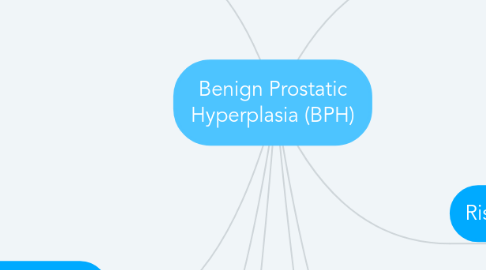
1. Clinical Manifestations
1.1. expanding prostatic tissue compresses the urethra
1.1.1. causes obstruction
1.1.2. voiding
1.1.2.1. incomplete bladder emptying
1.1.2.2. weak urinary stream
1.1.3. storage
1.1.3.1. frequency
1.1.3.2. incontience
1.1.3.3. nocturia
1.1.3.4. dysuria
1.1.3.5. bladder pain
1.1.3.6. urgency
1.1.4. Diverticula
1.1.4.1. results from the distention
1.1.4.2. infection can develop
1.1.4.2.1. can ascend from the bladder to the kidneys
1.1.4.2.2. hydroureter
1.1.4.2.3. hydronephrosis
1.2. pt reports sensations of incomplete bladder emptying
2. Diagnostic Tests
2.1. DRE
2.1.1. palpate the prostate gland
2.1.1.1. determine its size and condition
2.2. PSA
2.2.1. rules out prostate cancer
3. SURGERY
3.1. TUNA
3.1.1. Radiowaves
3.1.1.1. burns away regions of enlarged prostate
3.1.1.2. improves flow of urine
3.2. TURP
3.2.1. most common
3.2.2. removing obtructing prostate tissue
3.3. TUIP
3.3.1. used with smaller prostate glands
3.3.2. used to make small incisions
3.3.2.1. the gland is split to reduce pressure
4. Non-pharmacologic Therapy
4.1. urinating
4.2. avoid alcohol and caffeine
4.3. drinking small amounts of fluids
4.4. reducing stress
4.5. avoiding over the counter drugs
4.6. exercising
5. Prostate
5.1. prostate gland
5.1.1. Prostatodynia
5.1.1.1. pt experience the symptoms of prostatitis but no evidence of infection
5.1.2. Prostatistis
5.1.2.1. inflammation disorder of prostate gland
5.1.3. decrease the outflow of urine
5.1.3.1. obstruction of urine
5.2. increase # of cell
5.2.1. WHERE?
5.2.1.1. Periurethral gland
5.2.1.1.1. inner layers of prostate
5.2.2. WHAT?
5.2.2.1. Hyperplasia
5.3. Growth of prostate
5.3.1. WHY?
5.3.1.1. Androgens
5.3.1.1.1. WHERE?
5.3.1.1.2. DHT
5.3.1.1.3. WHAT IS IT?
6. Risk Factors
6.1. AGE
6.1.1. rarely causes BPH before age 40 and 60s
6.1.2. 90% of men in 70s and 80s can get BPH
6.2. Presence of Testes
6.2.1. removal of testes dont develop BPH
6.3. RACE
6.3.1. blacks
6.3.2. hispanics
7. Pharmacologic Therapy
7.1. 5-alpha reductase inhibitors
7.1.1. inhibit the conversion of testosterone to DHT
7.1.1.1. Avodart
7.1.1.2. Proscar
7.2. Alpha-blockers
7.2.1. relax smooth muscles to relieve obstruction and increase urine flow
7.2.1.1. Hytrin
7.2.1.2. Flomax
7.2.1.3. Uroxatral
7.3. Avoid
7.3.1. antihistamines
7.3.2. TCAs
7.3.3. phenothiazines
